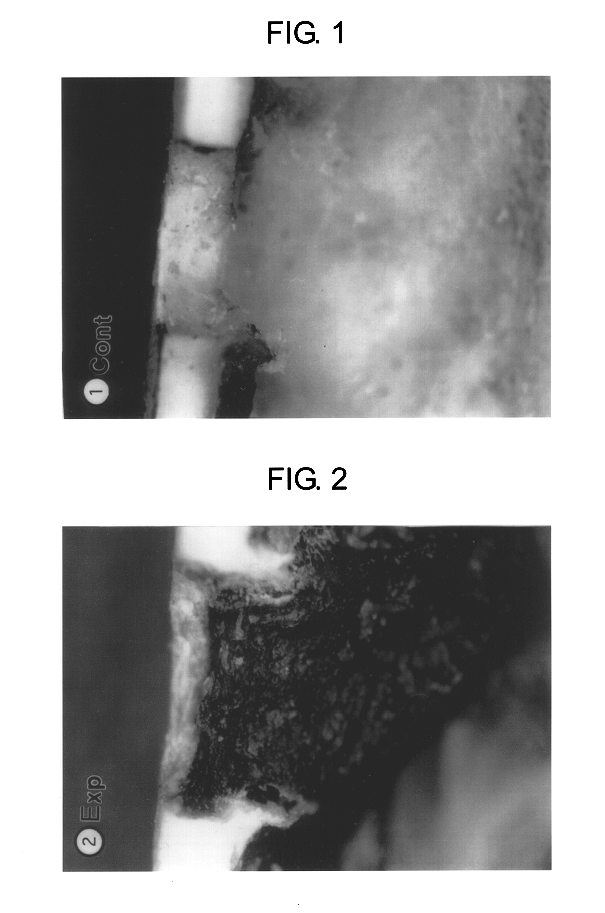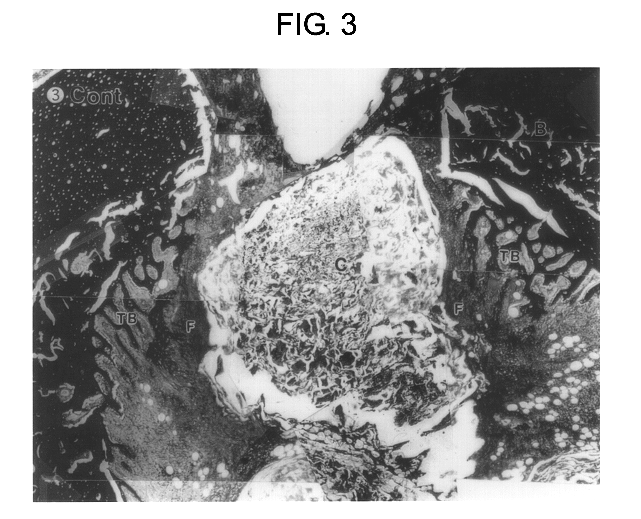Bone regeneration material
a bone regeneration and material technology, applied in the field of bone regeneration materials, can solve the problems of wasting time and money, affecting the healing effect of patients, and affecting the healing effect of patients, and achieving the effect of restoring the original shape of the bon
- Summary
- Abstract
- Description
- Claims
- Application Information
AI Technical Summary
Problems solved by technology
Method used
Image
Examples
example 1
A white rabbit (from New Zealand, body weight 3 kg) was subjected to anesthetic injection, and the thighbone thereof was exposed. Two holes were formed in the neck of the thighbone and near the joint cone, an end of the thighbone using a sterilized drill (3 mm in diameter) until the tip of the drill reached the soft tissue of the thighbone. A collagen tape (CollaTape, supplied by Calcitec) having a size of 1 cm.times.1 cm was immersed in 30 ml of a 2% sodium polyphosphate (average chain length 75) aqueous solution, and sterilely dried. This collagen tape was embedded in the hole formed in the thighbone on the right leg of the white rabbit. Further, a collagen tape immersed in sterile water as a control was embedded in the hole formed in the thighbone on the left leg of the white rabbit. In this state, the incised portions were sutured, and the conditions of the new bone generation in the holes of the thighbone after 1 and 2 weeks were observed. The thighbones extracted for observati...
example 2
Holes were formed in the thighbone of the white rabbit in the same manner as in Example 1. Ten milligrams of a human dust bone (particle diameter from 250 to 300 mm) demineralized was immersed in 30 ml of a 2% sodium polyphosphate (average chain length 75) aqueous solution, and sterilely dried. This dust bone was packed in the hole formed in the thighbone on the right leg of the white rabbit. Further, a dust bone immersed in sterile water as a control was packed in the hole formed in the thighbone on the left leg of the white rabbit. In this state, the incised portions were sutured, and the state of the new bone formation in the holes of the thighbone after 2 weeks was histologically observed in the same manner as in Example 1. FIG. 7 shows the results of the electron microscope of the sample treated with the dust bone immersed in sterile water. The hole was mainly filled with the dust bone (DB) and the fibrous tissue (F), and the new trabecular bone was observed only thinly. FIG. 8...
example 3
Holes were formed in the thighbone of the white rabbit in the same manner as in Example 1. A collagen tape was immersed in 30 ml of a 2% aqueous solution of sodium polyphosphate (Polyphosphate glass, supplied by Sigma) having various chain lengths, and sterilely dried. The collagen tape was embedded in the hole formed in the thighbone on the right leg of the white rabbit. Further, a collagen tape immersed in sterile water as a control was embedded in the hole formed in the thighbone on the left leg of the white rabbit. In this state, the incised portions were sutured, and the state of new bone formation in the holes of the thighbone after 2 weeks was histologically observed. The chain lengths of sodium polyphosphate used were, in terms of the phosphoric acid group. (1) an average chain length of 15 (Na.sub.17 P.sub.15 O.sub.46), (2) an average chain length of 25 (Na.sub.27 P.sub.25 O.sub.76), (3) an average chain length of 35 (Na.sub.37 P.sub.35 O.sub.106) and (4) an average chain l...
PUM
 Login to View More
Login to View More Abstract
Description
Claims
Application Information
 Login to View More
Login to View More - R&D
- Intellectual Property
- Life Sciences
- Materials
- Tech Scout
- Unparalleled Data Quality
- Higher Quality Content
- 60% Fewer Hallucinations
Browse by: Latest US Patents, China's latest patents, Technical Efficacy Thesaurus, Application Domain, Technology Topic, Popular Technical Reports.
© 2025 PatSnap. All rights reserved.Legal|Privacy policy|Modern Slavery Act Transparency Statement|Sitemap|About US| Contact US: help@patsnap.com



